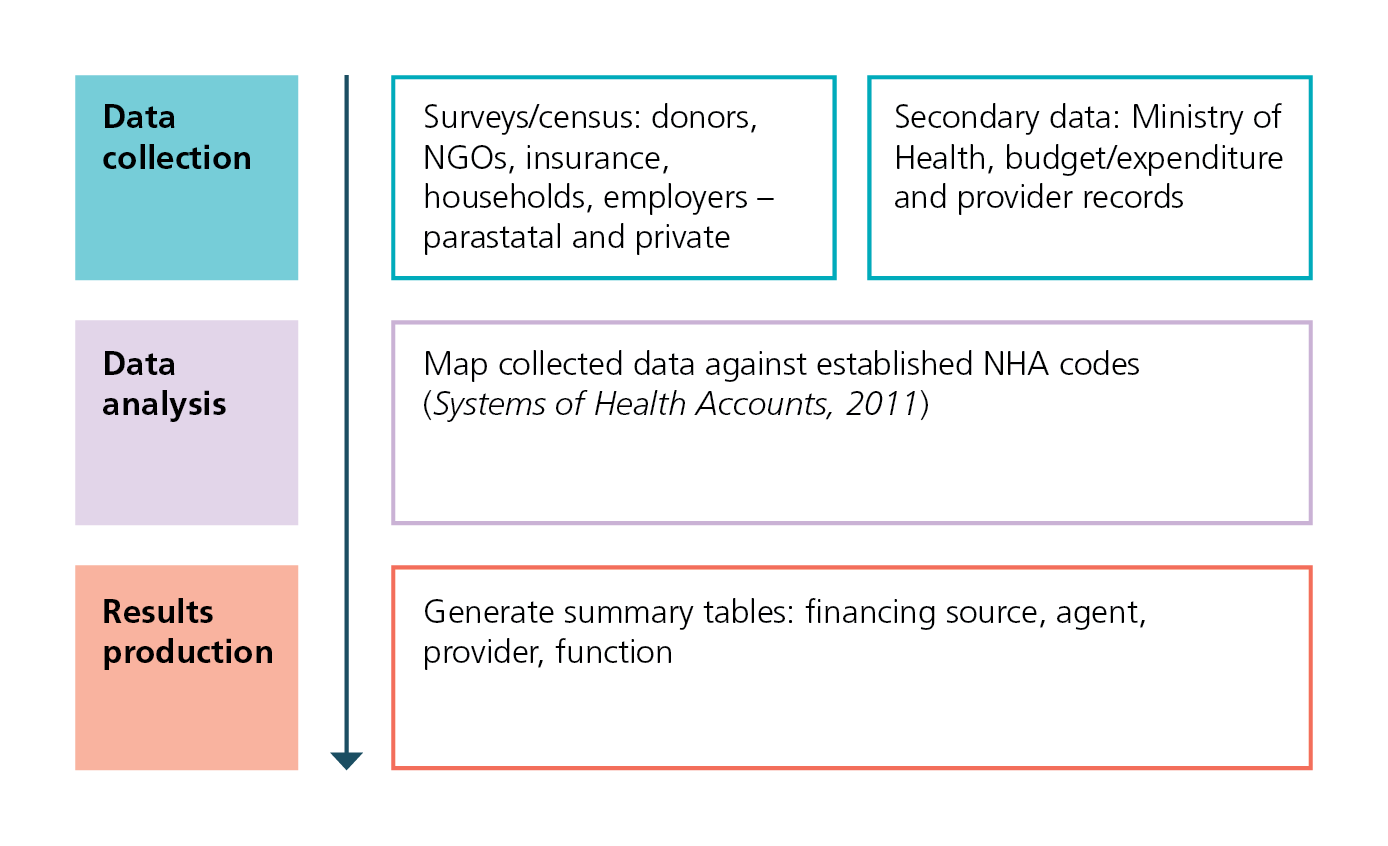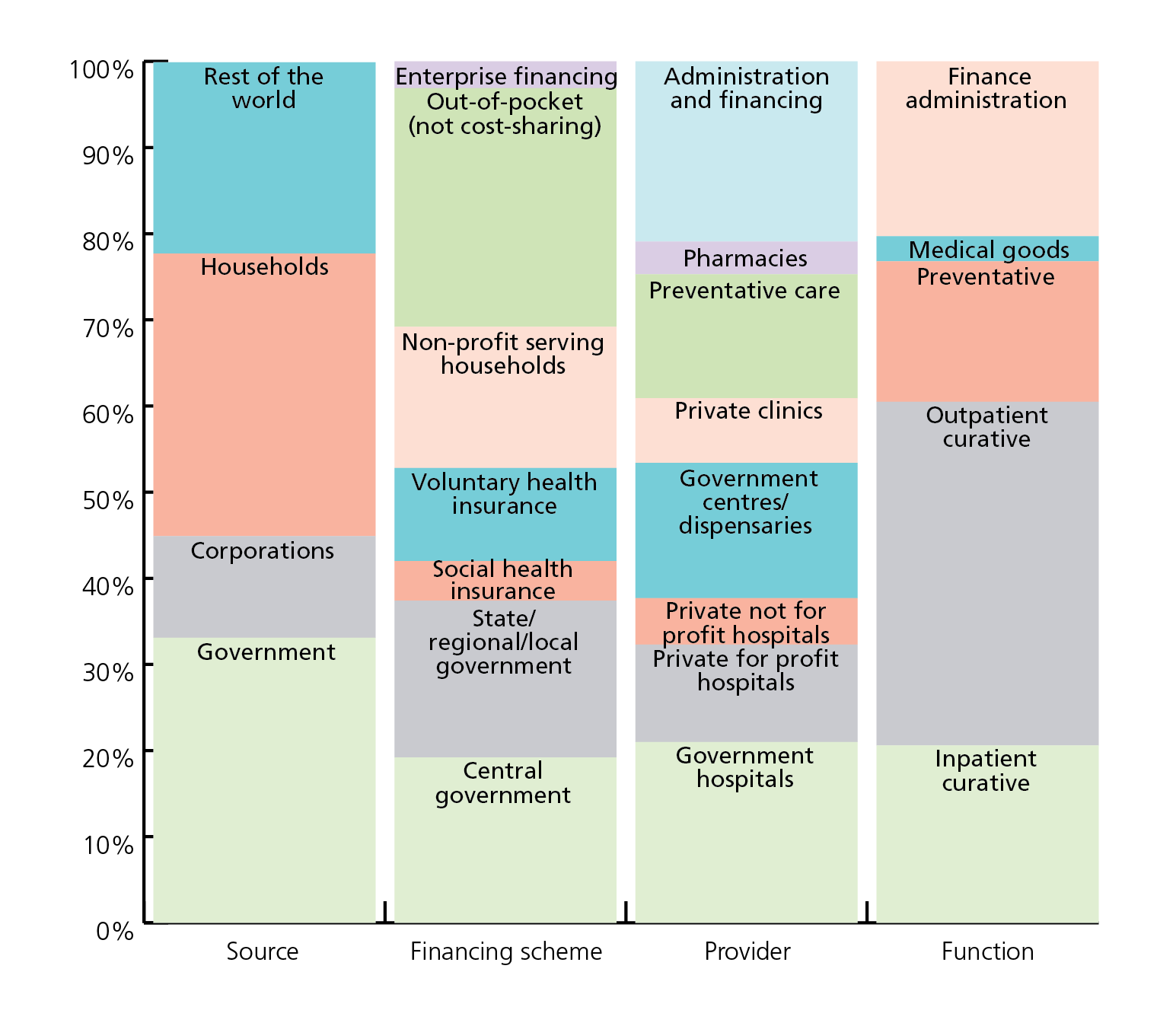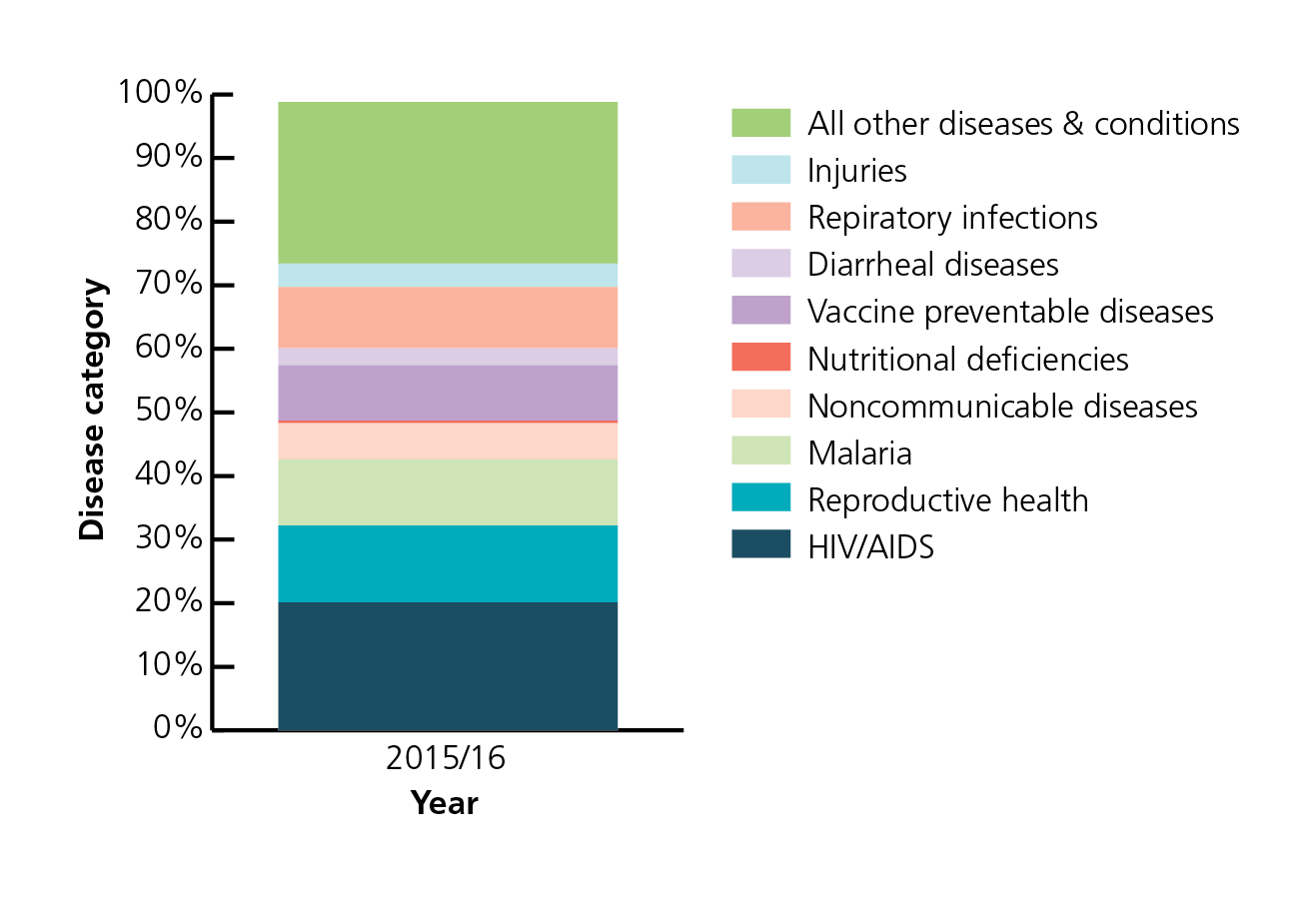
Image by Gino Crescoli from Pixabay
What are National Health Accounts?
National Health Accounts measure total health spending in a country in a given time period, providing answers to questions such as:
- How does the health system mobilize and manage its resources?
- Who pays for healthcare and how much do they pay?
- Who uses which goods and services?
- How is spending distributed across services, interventions and activities?
- Who benefits from the spending?
Why collect health financing data?
Health financing information allows policymakers, donors, and other stakeholder to make informed decisions on how to allocate resources between competing priorities. Such data are especially consequential for health policymaking and planning in countries where resources are limited and their supply is unpredictable.
Universal Health Coverage (UHC) states that ‘all people and communities can use health services they need, of sufficient quality to be effective, while also ensuring that the use of these services does not expose the users to financial hardship’. The international community use National Health Accounts to track the progress made by countries in their efforts to achieve UHC.
National Health Accounts generate the data to measure two indicators of financial protection, or whether households have access to quality health services without facing financial hardship:
- Catastrophic health expenditure measures the proportion of households whose out-of-pocket expenditures on health exceed a threshold of their total income that could lead them into poverty.
- Impoverishment measures the fraction of households that become impoverished because of having to pay for healthcare through out-of-pocket payments and are therefore pushed further into poverty.
Tools to track health resources
National Health Accounts provide the most comprehensive and internationally accepted methodology for tracking the flow of health resources within the health system. Other health resource tracking tools include:
National AIDS Spending Assessment
The National AIDS Spending Assessment tracks the flow of resources spent responding to HIV/AIDS using methods similar to NHA.
Public Expenditure Reviews
Public Expenditure Reviews examine the composition and structure of public spending and can be applied to specific sectors including health.
Public Expenditure Tracking Surveys
Public Expenditure Tracking Surveys track the flow of public resources and material resources from the level of the national government, through administrative decision points, and ultimately to frontline service providers; with the aim of improving quality of services provided by the lower level structures.
Health Budget Analysis
Health Budget Analyses examine trends in and the size of budget allocation to the health sector including a split of the budget by recurrent and development expenditure, by economic and functional classifications and by programmes to assess how governments allocate resources to the health sector and the areas these funds cover.
System of health accounts
The Organization of Economic Cooperation and Development (OECD) requires member countries to report their domestic health expenditures annually using a standardised format known as the System of Health Accounts (SHA). OECD first published the System of Health Accounts in 2000
In 2003, the USAID, World Bank, and the World Health Organization adapted the System of Health Accounts framework for use in low- and middle-income countries, producing the Guide to Producing National Health Accounts
The OECD published a revised version of the System of Health Accounts framework in 2011 strengthening classifications to support production of detailed analyses and introducing new classifications that expand the scope of analysis and provide a more complete look at the expenditure flows within a health system.
The World Health Organization supports the production of health accounts by providing tools and training accountants on the revised framework (SHA 2011)
The National Health Accounts process
The National Health Accounts team usually consists of representatives from the national statistical office, ministries of health and finance and academic and research institutions. Together they produce the health accounts.
The USAID-funded Health Systems 20/20 Project, with support from the World Health Organization and the World Bank, developed the National Health Accounts Production Tool (NHAPT) User Guide to streamline the process of data entry, analysis, and results production.

The National Health Accounts process
Sources of data
The National Health Accounts team collects financial and expenditure data from primary and secondary sources. The team usually extracts government expenditure data from appropriation records and budget documents. They use surveys, and in some cases censuses, to obtain expenditure data from other sources such as donors, insurance, private firms, parastatals and households.
For instance, investigators administer a questionnaire to a sample of private firms to extract financial and health expenditure data. They then extrapolate from these survey data to generate an estimate that represents health spending by all private firms in the country. To estimate how much households are spending on health at a point in time, investigators administer a household health expenditure and utilization survey to a representative sample of households. For example the Kenyan Health Expenditure and Utilization Survey.
The team uses the findings of available household health expenditure surveys to estimate total spending on health by households including out-of-pocket payments. Examples of internationally conducted surveys that contain household expenditure for health are the:
World Health Survey (WHS)
WHS was implemented by WHO in 2002–2004 in partnership with 70 countries to generate information on the health of adult populations and health systems. The total sample size in these cross-sectional studies includes over 300 000 individuals.
Living Standard Measurement Survey
The LSMS is a research project initiated in 1980. It is a response to a perceived need for policy relevant data that would allow policy makers to move beyond simply measuring rates of unemployment, poverty and health care use, for example, to understanding the determinants of these observed social sector outcomes.
Household Budget Survey (HBS)
HBS is a national survey focusing on households’ expenditure on goods and services, giving a picture of living conditions in the European Union (EU). It is carried out by each Member State and is used to compile weightings for important macroeconomic indicators, such as consumer price indices (used as measures of inflation) and national accounts.
Demographic and Health Surveys (DHS)
The DHS now has an optional household expenditure module
Other secondary sources of National Health Accounts data include government executed budget and expenditure reports, service provision assessments, public expenditure reviews, and health information systems.
Indicators
Until the revised 2011 SHA framework, National Health Accounts primarily reported:
- Annual total health expenditure (THE). THE is the sum of all public and private expenditures on health including capital health expenditures expressed as per capita health expenditure or as a percentage of the gross domestic product.
NHA now also report:
- Current health expenditure (CHE) which refers to all healthcare goods and services the health system has used or consumed during a year whereas capital spending or gross capital formation
- Capital spending (HK) which refers to purchases of new assets which the system uses repeatedly over several years. HK includes investments in buildings, machinery, technology and stocks of vaccines.
The separation of current and capital expenditures improves comparability between countries and over time. The level of resources invested in infrastructure, equipment and information technology tends to fluctuate more than current spending on health services but improves the resilience of the health system.
Standard results output
The 2011 revised Framework proposes results based on three core dimensions that are mandatory for all OECD countries:
- Financing schemes: The rules and regulations surrounding the financing arrangements that fund healthcare or the main types of financing arrangements through which people receive healthcare. Examples include – national health insurance, private health insurance, and government-financed programmes run through national ministries.
- Healthcare providers: Actors that deliver healthcare. Examples include – clinics, hospitals, pharmacies, and health centres.
- Healthcare functions: Type of health services or goods that are consumed. Examples include – prevention programmes, out-patient services, drugs consumed at home, and health systems governance and regulation.
The extended framework proposes four additional optional classifications:
- Revenues of health financing schemes which are type of revenue collected by financing schemes and include voluntary prepayment from employers for health insurance, internal transfers of tax revenue, and mandatory prepayment from households
- Financing agents which manage health expenditures
- Factors of provision such as drugs, consumables, salaries, and utilities
- Beneficiary characteristics that describe the individuals that consume healthcare such as disease, gender, age, and sub-national region.
The Health Accounts Analysis Tool guides the NHA team to produce standard tables and diagrams.

Current health expenditure for Kenya 2015/16: National health Accounts by revenue source, financing schemes, health providers and health functions
Disease sub-accounts
In addition to examining overall healthcare expenditures, some National Health Accounts teams conduct sub-analyses for specific conditions or programmes. Information on expenditure by disease can assist in allocating resources to those programmes, answering questions such as:
- What diseases/conditions are consuming healthcare resources, and how much?
- Which schemes pay for the services that address these diseases or conditions, and how much?
- How is spending on certain diseases broken down according to types of care?

Current health expenditure by disease (illness or condition), Kenya 2015/16 National Health Accounts
Challenges
It is challenging to generate National Health Accounts estimates is collection and triangulation of data from several sources. The process can be time-consuming and tedious and requires consistency.
The purpose of conducting the National Health Accounts estimation needs to be clear right from the beginning of the process as this will ensure collection of all the required data.
To maintain ownership, stakeholder participation is important especially if the results are to inform the policy process. That is why it is recommended that trained members of the National Health Accounts team undertake the estimation process as opposed to employing external consultants to construct the National Health Accounts estimates.
Contents
Source chapter
The complete chapter on which we based this page:
Maina T., Mwai D. (2019) Tracking Health Resources Using National Health Accounts. In: Macfarlane S., AbouZahr C. (eds) The Palgrave Handbook of Global Health Data Methods for Policy and Practice. Palgrave Macmillan, London.
Additional resources
The OECD maintains an interactive database of all NHA aggregates and indicators in each of the domains for each of its 35 member countries. Comparisons of the indicators show patterns in health spending,
The World Health Organization maintains the Global Health Expenditure Database and provides Health Expenditure Maps.
The World Health Organization also runs a Country Health Accounts Platform to strengthen the capacity of country health account teams to report health expenditures using the global standard, the System of Health Accounts 2011, and to analyse and produce policy relevant reports.
World Health Organization. Guide to producing national health accounts with special applications for low-income and middle-income countries.
World Health Organization, International Bank for Reconstruction and Development/The World Bank. Tracking Universal Health Coverage: 2017 global monitoring report.
OECD/Eurostat/WHO. A system of health accounts 2011: Revised edition.
World Health Organization. World health report 2010. Health systems financing: the path to universal coverage.
World Health Organization. National health accounts production tool (NHAPT) user guide.
World Health Organization. Technical briefs published on the World Health Organization’s Global Health Expenditure Database.
World Health Organization. Global health expenditure database.

